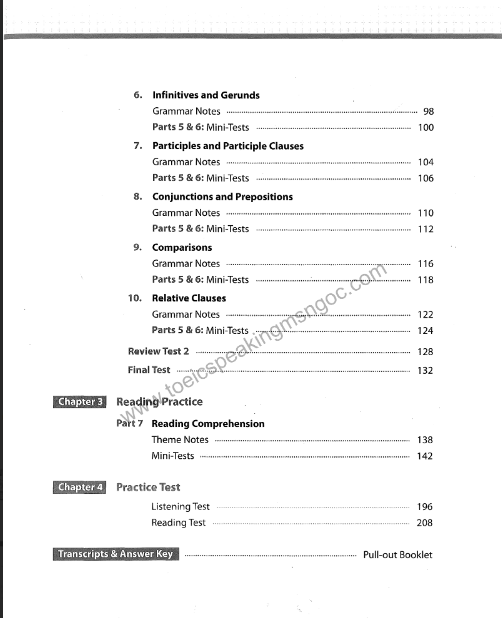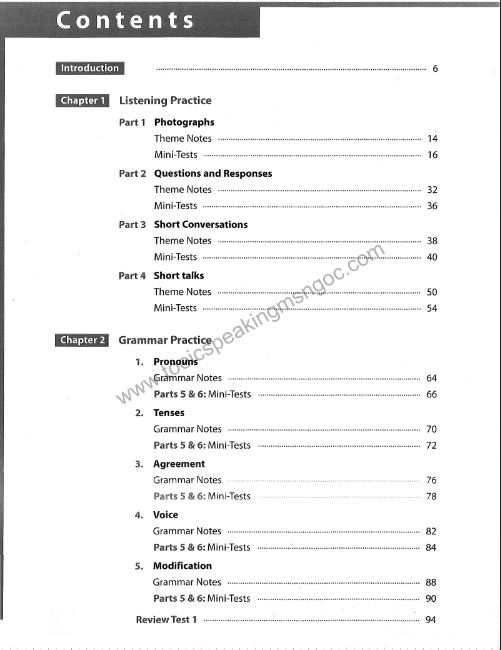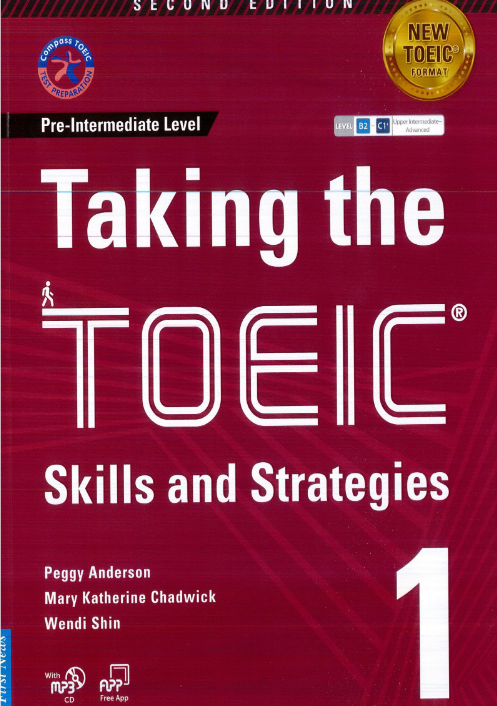


**Introduction** i. **What is Taking the TOEIC® Second edition?** Taking the TOEIC® is a comprehensive guide to taking the TOEIC® Listening and Reading Test. This book can be used as the perfect companion manual for self-learners or as a classroom text. The book is targeted for those who have experience with the TOEIC® test but are looking to improve their basic TOEIC® skills, fix commonly-made errors, and polish their English grammar to avoid simple mistakes. This book is made up of four chapters: three go over each section of the test in detail, and one is a practice test. **Chapter 1 Parts 1 – 4 (Listening Practice)** Each unit within the Listening Practice chapter features sample questions and answers and provides helpful hints for developing strategies to recognize relevant information in listening passages. Part 1 introduces common themes restored in Part 1 of the TOEIC®, such as the home, the workplace, and public places. Part 2 focuses on the most common question types and provides practice in identifying key points and particular structures of interest in the TOEIC®. The lessons also provide exercises based on the format of TOEIC® grammar questions, which allow students to practice their understanding of the grammar points. These exercises include vocabulary comprehension, sentence completion, and grammar exercises. Additional practice is provided in mini-tests at the end of each lesson. These mini-tests use the format of questions found in Parts 5 and 6 of the TOEIC®, combining grammar and vocabulary practice. After five lessons, students may measure their progress with review tests. There is also a cumulative final test at the end of the chapter. **Chapter 2 Parts 5 and 6 (Grammar Practice)** Lessons within the Grammar Practice chapter outline fundamental grammar points frequently tested on the TOEIC®. Each lesson begins with a brief explanation of the grammar target including key points and particular structures of interest in the TOEIC®. The lessons also provide exercises based on the format of TOEIC® grammar questions, which allow students to practice their understanding of the grammar points. These exercises include vocabulary comprehension, sentence completion, and grammar exercises. Additional practice is provided in mini-tests at the end of each lesson. These mini-tests use the format of questions found in Parts 5 and 6 of the TOEIC®, combining grammar and vocabulary practice. After five lessons, students may measure their progress with review tests. **Chapter 3 Part 7 (Reading Practice)** The Reading Practice chapter introduces sample texts to familiarize students with the kinds of materials they will encounter on the TOEIC®, such as emails, letters, brochures, tables, chat room excerpts, text messages, articles, and reports—together with examples of the kinds of questions students may expect to find in this part of the test. The mini-tests provide extensive test practice using the format of questions found in Part 7 of the TOEIC®. **Chapter 4 Practice Test** The Practice Test chapter provides students with a full-length test including 100 listening test questions and 100 reading test questions. An answer key and MP3 files are provided for all the test questions. For the listening sections, transcriptions of all passages and questions are available, as well as explanations for Part 5 & 6 questions. There is also an accompanying application for this book. The app will enhance the learning experience by providing more customized practice for students. This will allow students to truly focus on their areas of weakness. The simplified grammar and theme-based texts of Taking the TOEIC® provide pre-intermediate to intermediate students with access to TOEIC® practice materials appropriate for building their test-taking skills without the frustration of encountering overly complicated vocabulary and grammar structures. Taking the TOEIC® builds an excellent foundation for students preparing for the TOEIC® test. **App Features** **For classroom users:** Teachers can create an interactive classroom using this book by having students answer questions in real-time. Answers are delivered instantly to the teacher, showing them exactly where students are struggling and excelling. This allows teachers to target their students’ weaknesses. Teachers can choose topics based on the areas that they would like to work on. The application will provide questions based on that question type to drill students. Teachers have complete control over the type and number of questions they use. The questions are delivered to the student’s smartphone/tablet/PC, and answers will then be reported back to the teacher. On the website, teachers will be able to view and print out individual student records or entire class reports. **For self-study users:** Self-study users may use the app to access the MP3s. The students will also be able to use this app to gauge how well they are doing by using the question database and practice lots of different questions, focusing on parts they frequently get wrong. Students can figure out which parts they need to work on by checking their scores on the student website. **How to get the app:** Google Play Store: “Classloop” Apple App Store: “Classloop” **Website Features (www.classloop.net)** Through the website, teachers and students can view detailed reports of their results and progress as they use Taking the TOEIC®. The site gives recommendations about areas for improvement and additional practice questions. In addition, teachers can make customized TOEIC tests from an available pool of questions. — **Hình 2:** **Vocabulary Use** **A. Fill in the blank with the appropriate word.** 1. Our company is hoping to ______ the bid for the construction contract. (A) overcome (B) triumph (C) win (D) conquer 2. When you ______ this package, please use express mail. (A) separate (B) suppress (C) send (D) resign 3. When we arrived, the keynote ______ was about to start. (A) language (B) communication (C) speech (D) expression 4. When Don resigned from his post, Charles ______ the role of department manager. (A) assumed (B) succeeded (C) gave (D) compensated **Words & Expressions** * express mail * keynote speech * resignation * to assume * to compensate * to resign **B. Incomplete Sentences** **Choose the word or phrase that best completes the sentence.** 1. He expects his client ______ within the hour. (A) arrive (B) arrival (C) to arrive (D) arriving 2. Sally ______ to not sending the application in time for registration. (A) to be admitting (B) admitting (C) admitted (D) admit 3. The old couple ______ to our restaurant every day for over a year. (A) be coming (B) came (C) coming (D) to come 4. Do not ______ a contract with anyone without meeting them first. (A) make (B) to make (C) making (D) made **C. Text Completion** **Choose the best word or phrase for each blank.** With the exception of some of our long-term customers using our appliances, it seems we are losing our position in the industry. After ______ our sales results for the past two quarters, we are aware that many of our customers are switching to our competitors. We need to find out why these customers have left, and see what needs we were unable to address. For our next meeting, I want you to come up with some ways ______ this concern. (A) to examine (B) examined (C) examining (D) to have examined It’s clear that many of our customers are switching to our competitors. We need to find out why these customers have left, and see what needs we were unable to address. For our next meeting, I want you to come up with some ways ______ this concern. (A) to address (B) to have addressed (C) addressing (D) to be addressing — **Mini-Test** **Choose the word or phrase that best completes the sentence.** [Answer Key p.27] 1. Mr. Greenwich is well-regarded as being an ______ in negotiations. (A) employee
9. Dr. Valoro was asked ________ the keynote speech at this year’s annual investors’ meeting. (A) to have given (B) to give (C) giving (D) having given 10. It is important ________ clients feel confident that you have their best interests at heart. (A) making (B) to make (C) to be making (D) having made 11. Dennis helped me ________ all the data from the survey. (A) to enter (B) entering (C) to have entered (D) entered 12. Despite not ________ experience in sales, Kyle seemed naturally comfortable when meeting customers. (A) having (B) to have (C) to have had (D) have 13. We regret ________ you that your loan application has
Grammar Notes 1 Participles Participles are verbs that take on an adjective form. They go before a noun or at the beginning of an adjective clause. The endings of these participles change depending on whether the nouns they describe are the agent of the verb forming the participle. 2 Forms of Participles A. If the noun is the agent (doing the action expressed in the participle), choose an -ing form. B. If the noun is NOT the agent, choose an -ed form. * The results of the first quarter were confusing to shareholders. * After a confusing start, the workshop continued with no problems. * The owner felt confused after investment in marketing failed to pay off. * The confused employee asked his coworker for help. 3 Participle Clauses A. An -ing form can be used when two things occur at the same time. * Jake submitted his resume, hoping to get a job at the company. B. An -ing form can be used when one action occurs as a result of the first action. * Struggling tirelessly, the company eventually found itself ranked in the top three in the industry. C. An -ing clause can be an explanation of the following main clause. * Feeling tired, he left the office early. D. An -ed form can be used when the object of the verb expressed in the participle serves as the subject of the main clause. * Situated on a hill, the hotel commands a fine view. E. An -ed form can be used after if, when, while, once, and until, particularly in formal style. * Once switched on, the photocopier needs time to warm up. * If asked to sign the contract, make sure you read it carefully.


